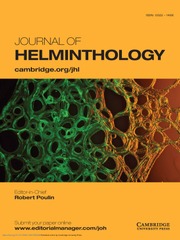Article contents
Larvae of Spirocerca lupi and another spirurid species in the same dung beetles: notes on species identification
Published online by Cambridge University Press: 17 February 2023
Abstract
Various dung beetle species of the family Scarabaeidae have been reported as intermediate hosts of Spirocerca lupi from different geographical locations, but there has been no data from south-east Asian countries. In the present study in Vietnam, by using morphological and molecular approaches, we identified the third-stage larvae of S. lupi for the first time in two dung beetle species, Catharsius molossus and Copris szechouanicus, adding them as new intermediate hosts of this nematode. In addition, both beetle species were infected with larvae of another spirurid nematode of Physocephalus sp. At large magnifications above 200×, these two spirurid larvae can be differentiated from each other by their body size (1880–2662 vs. 1417–1635 μm) and detailed morphological features of the anterior and posterior ends, such as the length of the buccal cavity, the position of the nerve ring and excretory pore, and tail characters. However, it is difficult to distinguish them at a lower magnification due to their minute size. Moreover, morphometric data of S. lupi larvae vary among reports and the body length may overlap with that of Physocephalus sp., thus, misidentification may occur, indicating the necessity of careful examination for accurate identification. The findings of the present study also supposed that larvae of S. lupi and more spirurid nematodes may be concurrently found in various dung beetle species, including C. molossus and C. szechouanicus, in other south-east Asian countries. Thus, more investigations in various countries should be conducted to identify spirurid larvae from dung beetles in order to fully understand their role as intermediate hosts of S. lupi and other spirurid nematodes.
Information
- Type
- Research Paper
- Information
- Copyright
- Copyright © The Author(s), 2023. Published by Cambridge University Press
References
- 1
- Cited by

